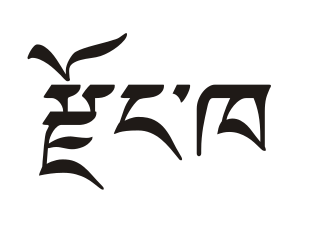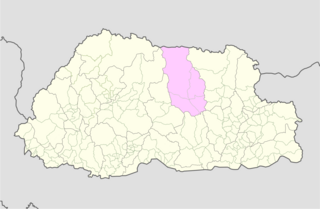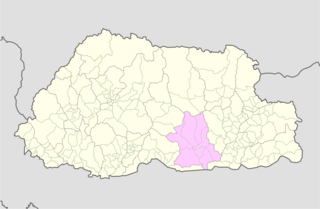Related Research Articles

Dzongkha is a Tibeto-Burman language that is the official and national language of Bhutan. It is written using the Tibetan script.

Bumthang District is one of the 20 dzongkhag (districts) comprising Bhutan. It contains numerous temples and Buddhist sacred sites. The district is divided into four gewogs, each corresponding to a major glacial valley: Choekor, Tang, Ura, and Chhume. The latter valley is also called Bumthang, lending its name to the whole district.

Mongar District is one of the 20 dzongkhags (districts) comprising Bhutan. Mongar is the fastest-developing dzongkhag in eastern Bhutan. A regional hospital has been constructed and the region is bustling with many economic activities. Mongar is noted for its lemon grass, a plant that can be used to produce an essential oil. It also has a hydroelectric power-plant on the Kuri Chhu river. Mongar is notable for having the longest work time in all the dzongkhags of Bhutan.

Zhemgang District, is one of the 20 dzongkhags (districts) comprising Bhutan. It is bordered by Sarpang, Trongsa, Bumthang, Mongar and Pemagatshel Districts, and borders Assam in India to the south. The administrative center of the district is Zhemgang.
The Kheng people are found primarily in the Zhemgang, Trongsa, Bumthang, Dagana, and Mongar Districts of central Bhutan. They speak the Kheng language, a member of the extended Sino-Tibetan language family belonging to the East Bodish languages group; it is mutually intelligible with the Bumthang language and Kurtöp language to the north. The Kheng people are ethnolinguistically same as the Bumthang people and Kurtöp people of central Bhutan and are more closely related to Ngalop people of western Bhutan than to their neighbors in eastern Bhutan, who are primarily Sharchops and speak Tshangla language. SIL International estimates there are 50,000 Kheng speakers as of 2009.
Tshangla is a Sino-Tibetan language of the Bodish branch closely related to the Tibetic languages. Tshangla is primarily spoken in Eastern Bhutan and acts as a lingua franca in the region; it is also spoken in the adjoining Tawang tract in the Indian state of Arunachal Pradesh and the Pemako region of Tibet. Tshangla is the principal pre-Tibetan language of Bhutan.

Trongsa District is one of the districts of Bhutan. It is the most central district of Bhutan and the geographic centre of Bhutan is located within it at Trongsa Dzong.

There are two dozen languages of Bhutan, all members of the Tibeto-Burman language family except for Nepali, which is an Indo-Aryan language, and the Bhutanese Sign Language. Dzongkha, the national language, is the only native language of Bhutan with a literary tradition, though Lepcha and Nepali are literary languages in other countries. Other non-Bhutanese minority languages are also spoken along Bhutan's borders and among the primarily Nepali-speaking Lhotshampa community in South and East Bhutan. Chöke is the language of the traditional literature and learning of the Buddhist monastics.
The Khengkha language, or Kheng, is an East Bodish language spoken by ~40,000 native speakers worldwide, in the Zhemgang, Trongsa, and Mongar districts of south–central Bhutan.
Bodish, named for the Tibetan ethnonym Bod, is a proposed grouping consisting of the Tibetic languages and associated Sino-Tibetan languages spoken in Tibet, North India, Nepal, Bhutan, and North Pakistan. It has not been demonstrated that all these languages form a clade, characterized by shared innovations, within Sino-Tibetan.
The East Bodish languages are a small group of non-Tibetic Bodish languages spoken in eastern Bhutan and adjacent areas of Tibet and India. They include:
The Kurtöp language is an East Bodish language spoken in Kurtoe Gewog, Lhuntse District, Bhutan. In 1993, there were about 10,000 speakers of Kurtöp.
Gongduk or Gongdu is an endangered Sino-Tibetan language spoken by about 1,000 people in a few inaccessible villages located near the Kuri Chhu river in the Gongdue Gewog of Mongar District in eastern Bhutan. The names of the villages are Bala, Dagsa, Damkhar, Pam, Pangthang, and Yangbari (Ethnologue).
The Dzala language, also called Dzalakha, Dzalamat, or Yangtsebikha, is an East Bodish language spoken in eastern Bhutan, in the Lhuntse and Trashiyangtse Districts.

ʼOle, also called ʼOlekha or Black Mountain Monpa, is a moribund, possibly Sino-Tibetan language spoken natively by 1 person in the Black Mountains of Wangdue Phodrang and Trongsa Districts in western Bhutan. The term ʼOle refers to a clan of speakers.
The Chocha Ngacha language or Chochangachakha or Tsamang is a Southern Tibetic language spoken by about 20,000 people in the Kurichu Valley of Lhuntse and Mongar Districts in eastern Bhutan.
The Brokkat language is an endangered Southern Tibetic language spoken by about 300 people in the village of Dhur in Bumthang Valley of Bumthang District in central Bhutan. Brokkat is spoken by descendants of pastoral yakherd communities.

The Bumthang language ; also called "Bhumtam", "Bumtang(kha)", "Bumtanp", "Bumthapkha", and "Kebumtamp") is an East Bodish language spoken by about 20,000 people in Bumthang and surrounding districts of Bhutan. Van Driem (1993) describes Bumthang as the dominant language of central Bhutan.

The Takpa or Dakpa language, Dakpakha, known in India as Tawang Monpa, also known as Brami in Bhutan, is an East Bodish language spoken in the Tawang district of Arunachal Pradesh, and in northern Trashigang District in eastern Bhutan, mainly in Kyaleng, Phongmed Gewog, Dangpholeng and Lengkhar near Radi Gewog. Van Driem (2001) describes Takpa as the most divergent of Bhutan's East Bodish languages, though it shares many similarities with Bumthang. SIL reports that Takpa may be a dialect of the Brokpa language and that it been influenced by the Dzala language whereas Brokpa has not.
Nyenkha is an East Bodish language spoken by about 10,000 people in the eastern, northern, and western areas of the Black Mountains. Speakers live primarily between the Tang Chuu to the east and Mangde Chhu to the west, from the town of Trongsa in Trongsa District; along Black River passes in the Trongsa District villages of Taktse and Usar; to in Ridha and Tashiding villages, and Phobji, Dangchu, and Sephu Gewogs and surrounding villages in southeast Wangdue Phodrang District.
References
- 1 2 Nupbikha at Ethnologue (18th ed., 2015) (subscription required)
- ↑ Schicklgruber, Christian (1998). Françoise Pommaret-Imaeda (ed.). Bhutan: Mountain Fortress of the Gods. Shambhala. pp. 50, 53.
- ↑ van Driem, George (2007). "Endangered Languages of Bhutan and Sikkim: East Bodish Languages". In Moseley, Christopher (ed.). Encyclopedia of the World's Endangered Languages. Routledge. p. 295. ISBN 0-7007-1197-X.
- ↑ van Driem, George (2007). Matthias Brenzinger (ed.). Language diversity endangered. Trends in linguistics: Studies and monographs, Mouton Reader. Vol. 181. Walter de Gruyter. p. 312. ISBN 3-11-017050-7.
